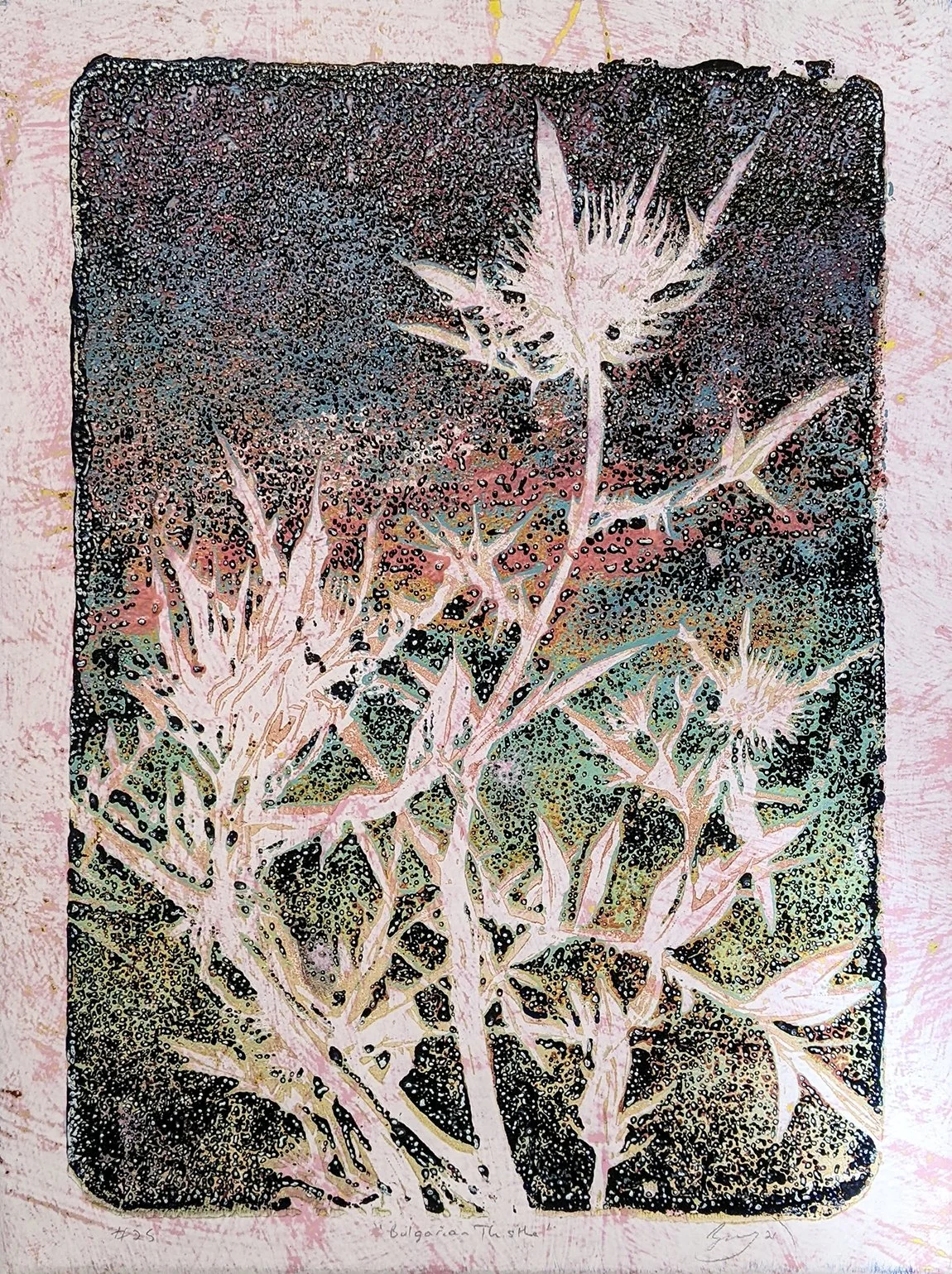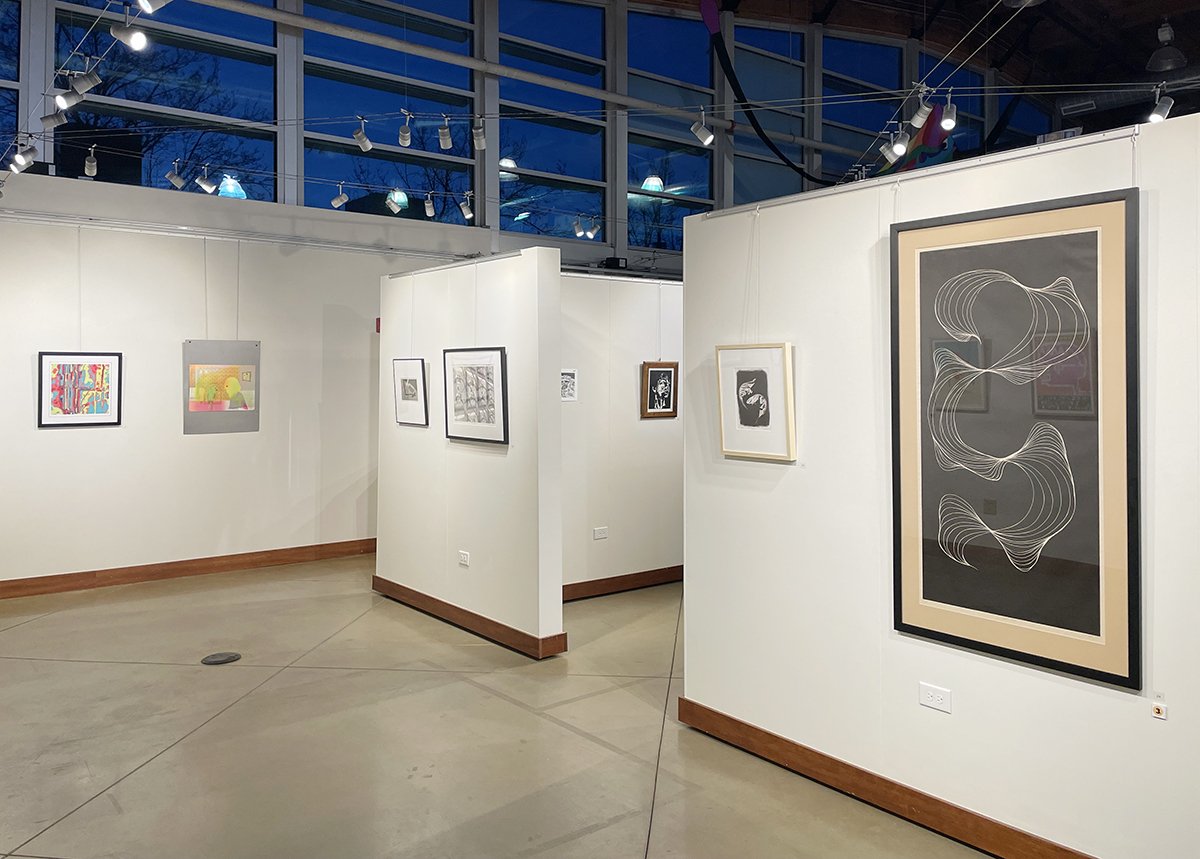Impressed: Transcendent Glitch
Impressed: Transcendent Glitch
Art Gym Gallery
1460 Leyden Street, Denver, CO 80220
March 24-April 20, 2022
Admission: Free
Review by Maggie Sava
Transcendent Glitch—the title for Art Gym Gallery’s fifth iteration of the Impressed national printmaking exhibit—sets an interesting tone for the show. Referring to an extraordinary error, it’s a surprising description for a juried exhibition featuring works of impressive technical skill from 27 different artists. Further, the term “glitch” connotes flaws in both the digital and electronic realms.
An installation view of the national juried exhibition Impressed: Transcendent Glitch at the Art Gym Gallery in Denver. Image by DARIA.
Glitch art, in fact, has become a subset within contemporary digital art in which the works center on malfunction. This may initially seem incongruous with a show where the printmaking mediums—including lithographs, monoprints, screen prints, and woodcuts, among others—emerge from analog, physical processes. But the development of printmaking and the printing press was an essential precursor to the development of all things digital. [1] And the theory that glitches expose what lies behind the curtain, unveiling the technology (and the hand) behind the art, opens the way to a range of interpretations of the Transcendent Glitch exhibit.
Works by Bryan Ritchie, Joseph Higgins, and Jennifer Scheuer on display in the Impressed: Transcendent Glitch exhibition. Image by Maggie Sava.
As theorist Michael Betancourt describes it, “The glitch is a way to see what our technology typically hides from us: the actual functioning of its processes, events that come into motion only because we have set them into motion.” [2] The practice of printmaking carries an implication of change and alteration. Even when artists use replicable processes and tools, printmaking will not always produce the exact same outcome. Inevitably, a work will change or shift in the process due to factors like skewed alignment or variations in ink application and color.
We can see these inconsistencies, in turn, as their own types of glitches. Yet in Transcendental Glitch, unintentional imperfection is not overtly visible. The theme does, however, emerge in several artistic interpretations blended into the finished works on view in the gallery.
Amze Emmons, Levity, 2018, screen print with laser cut elements, 20 x 15 inches. Image courtesy of the artist.
Amze Emmons’ work Levity, which took first place in the juried show, clearly visualizes the notion of the glitch. The picture pops forward from the backing of the frame, built outward to add dimension. By outlining the back of the paper in neon pink, Emmons makes the print look like it is backlit. And with this illusion of illumination using bright, unnatural color, he emphasizes the artificially constructed depth of the print. As Emmons notes, he is “employing chance and collage in the studio to create a moment of parataxis, where two or more disparate things can be put into conversation within the viewer’s mind through a trick of proximity.” [3]
Two cats lay to the right in the composition, balancing a trash can on the left. Tied to the trash can are balloons, one of which is cut out and outlined in neon yellow. This use of negative space interrupts the picture plane and makes it appear as if a piece of the image has been lost. Outlines are imperfectly drawn, not fully lining up with the shapes they are meant to define. The result is a feeling that something is awry. Emmons’ reference to parataxis, a linguistic collaging, is a fitting description of the work's purposeful imperfection and the uncanny, liminal landscape within the frame.
Troy Zaushny, Bulgarian Thistle, wax-cut monoprint, 12 x 16 inches. Image by Maggie Sava.
In Bulgarian Thistle, Troy Zaushny formulates his own conceptualization of the glitch. In his artist’s statement, he describes his work as “‘containers for chaos’.” [4] These containers of chaos transform into “something that I couldn’t have planned and could never reproduce.” [5] The image of a thistle—a weed that grows spontaneously in the natural environment—represents an uncontrolled force, and Zaushny’s technique underscores this sense of the untamable.
A detail view of Troy Zaushny’s Bulgarian Thistle, wax-cut monoprint. Image by Maggie Sava.
In his view, the process of monoprints symbolizes destruction, for it is “consumed” as he creates the art. [6] Each of his prints are unique works, made through the unreplicable application of colors on a block. [7] The result in Bulgarian Thistle is a thick and bubbling black texture outlining the plants and thus creating a negative image. The wax appears organic and amorphous, rather than in a controlled pattern. Yet despite its natural inspiration, the print as a whole resembles a digital image with altered or manipulated visual data.
Sydney McLeod, This Body Doesn’t Belong to Me, 2019, intaglio, 12 x 20 x 2 inches. Image by Maggie Sava.
This Body Doesn’t Belong to Me, an artist’s book by Sydney McLeod, stands apart from Emmons’s and Zaushny’s works in that it does not incorporate glitch overtly. Instead, change is suggested in the way McLeod creates ambiguity in her images of the human form. This Body Doesn’t Belong to Me contains prints of white, congealing bodies and body parts set against a black background.
While resembling ultrasounds or x-rays, McLeod’s images are also abstracted and imperfect rather than realistic anatomical depictions. The faces, hands, and crouched bodies look like sediment patterns settling across the page. [8] And the visual quality of the images bring up questions around McLeod’s process, such as: how much control did she have in creating these forms, and how much was left to chance?
A sample of the text in Sydney McLeod’s This Body Doesn’t Belong to Me, 2019, intaglio. Image by Maggie Sava.
Beyond the suggestion of the uncontrolled in the print illustrations, the book provides a beautiful poetic meditation on chronic illness and pain—both of which emphasize embodied experience and abstract one’s relationship with one’s own body. As McLeod explains, they are “a complex amalgam of companion, parasite, and weight and the ways in which those things become a part of my identity through my illness.” [9] The book is a means to “understand, and perhaps even exorcize the emotional toil of a chronic condition.” [10]
This Body Doesn’t Belong to Me describes the feeling of disconnection from the body in pain—a distancing that distorts the sense of possession of the body. As one line reads, “I left my body lying in a ditch somewhere. In its place I drag around someone else’s corpse. It wears my face and stole my voice, but I can feel the way it struggles to fit inside my skin.” McLeod uses her art practice to visualize an experience that is beyond control and choice, making the personal public.
A view of works in the Impressed: Transcendent Glitch exhibition. Image by DARIA.
While not all of the artists foreground the uncontrollable or the unexpected in their works as Emmons, Zaushny, and McLeod do, what ties the whole exhibition together is the diverse potential of the medium. Within the gallery space overall, the curation and layout of the show conveys this diversity through contrast. One wall that is filled with bright, colorful figurative prints balances the wall across from it, which holds black-and-white works. A wall of floral, anthropomorphic, and animal forms gives way to a nook of abstract prints. The range and skill of the artists is impressive, demonstrating that “glitch” is not a critical take on their work but rather a special nod to the unseen components and all the happy accidents and unintended happenings that are part of it.
The front façade of the Art Gym Denver. Image courtesy of the American Society of Landscape Architects Colorado.
Such an appreciation for creative practice fits the mission of the venue. Art Gym Denver is a shared workspace for artists focused on supporting their practice. With their membership, artists can access a variety of artmaking equipment. Art Gym also has residencies for artists, monthly art critiques that are open to the public, and workshops.
The venue hosts programs that draw attention to the complexities of technique, underscoring Impressed: Transcendent Glitch’s connection with Mo’Print’s larger celebration of the printmaking tradition across the Denver metropolitan area. Mo’Print (The Month of Printmaking) includes many exhibitions around the city focusing on printmaking, as well as workshops and other events highlighting the practice. More information, as well as a historical timeline of printmaking in Colorado, can be found at https://www.moprint.org/.
Maggie Sava is a writer based in Denver, Colorado. She holds a bachelor’s degree in Art History and English, Creative Writing from the University of Denver and a master’s degree in Contemporary Art Theory from Goldsmiths, University of London. Writing is her main artistic engagement, which she pursues through research, art writing, and poetry.
[1] Michael Betancourt, “IMHO, a column,” September 19, 2003, Miamiartexchange.com, https://www.michaelbetancourt.com/pdf/MAEX_Welcome_to_Cyberia_2003.pdf.
[2] Ibid.
[3] Amaze Emmons, Artist’s Statement.
[4] Troy Zaushny, Artist’s Statement.
[5] Ibid.
[6] Troy Zaushny, “Wax cut monoprints,” Troy Zaushny: multimedia arts, accessed April 3, 2022, http://zaushny.com/studio/reductive-wax-cut-monoprinting/.
[7] Ibid.
[8] McLeod’s images resemble artist Aldo Tambellini’s “black films,” which he made by manipulating film through scratching, burning, and painting—manual creations of glitch. “ALDO TAMBELLINI COLLECTION,” Harvard Film Archive, accessed April 3rd, 2022, https://harvardfilmarchive.org/collections/aldo-tambellini-collection.
[9] Sydney McLeod, Artist’s Statement.
[10] Ibid.
















